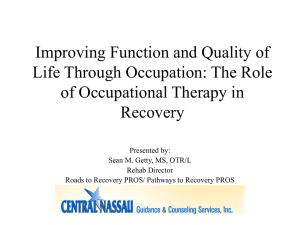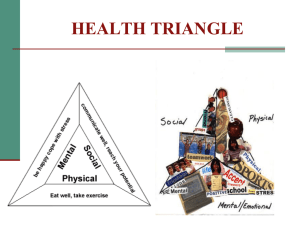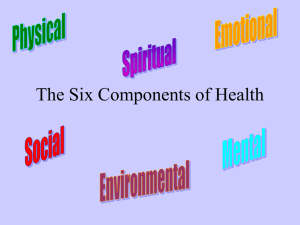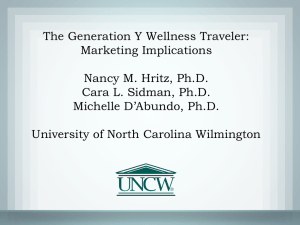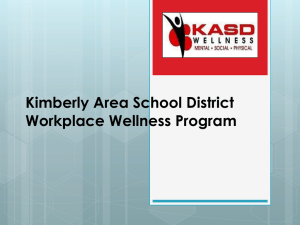2014-305 - Texas Occupational Therapy Association
advertisement
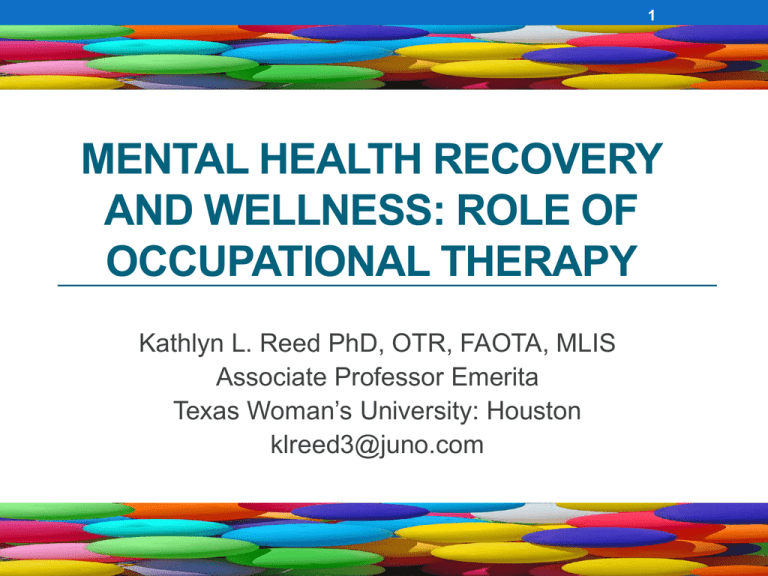
1 MENTAL HEALTH RECOVERY AND WELLNESS: ROLE OF OCCUPATIONAL THERAPY Kathlyn L. Reed PhD, OTR, FAOTA, MLIS Associate Professor Emerita Texas Woman’s University: Houston klreed3@juno.com 2 Objectives • Discuss concept of maintaining health and wellness after recovering from a mental illness • Describe programs developed by occupational therapists designed to assist in maintaining wellness and recovery • Illustrate examples of selected programs. 3 Criteria for Article Selection Included • Original article or abstract in English • Published between 2000-14 • One or more authors is an occupational therapist OR methodology includes an assessment developed by an occupational therapist(s) OR occupational therapy is used in methodology section AND data on one or more daily living activity is reported • 54 studies met criteria Excluded • Articles not in English • Articles published before 2000 • Articles in which the involvement of occupational therapy or occupational therapist(s) could not be established (authorship, data collector, therapist) or occupational therapy was used as the control group • Books, chapters, blogs, web pages, videos, news articles, CATs, protocols, clinical trial or grant proposals, Cochrane reviews 4 Search Strategy & Databases Search Strategy • Wellness OR recovery OR self help AND mental* ill* OR mental health OR psychiatr* OR psychotic OR psychosis OR neuropsychiatr* OR schizophrenia OR bipolar AND occupational therap* Databases • MEDLINE • Psychiatry & Behavioral • • • • • • Sciences PsycINFO CINAHL Proquest Nursing & Allied Health Health Reference Center OT Seeker Google 5 Definition: Wellness • Wellness is a conscious, deliberate process that requires a person to become aware of and make choices for a more satisfying lifestyle • A wellness lifestyle includes • a self-refined balance of health habits: • adequate sleep, rest, and good nutrition; • productivity and exercise; • participation in meaningful activity; and • connection with people and communities that are supportive. • Swarbrick M. (1997). A wellness model for clients. Mental Health Special Interest Section Quarterly, 20, 1-4. 6 Definition: Recovery • Definitions depend on perspective • Outcome: ability to lead a good and satisfying life despite illness or presence of symptoms (Deegan, 2001) • Process: a non-linear lived experience involving both selfdiscovery and transformation and culminating in an understanding that symptoms of illness are not definitive in terms of one’s self-identify (Davidson et al, 2005) • Philosophical underpinnings: concepts such as hope, connection, healing, empowerment, self-help, mutual-help, selfdetermination, family involvement, resiliency, choice, justice, responsibility, skill building, community involvement, education and role development, focus on strengths and possibilities, positive culture for healing. (Casey, 2008) 7 Changing Models Medical Model Wellness/Recovery • Professional in charge • Client centered • Focus on illness and • Focus on wellness and • • • • dysfunction Focus on disability and lack of competence Focus on controlling or reducing symptoms Tends to be reductionistic Goal is cure and eliminating symptoms of illness • • • • function Focus on ability and competence Focus on aspects of health, well-being Tends to be holistic Goal is “doing” daily activity regardless of symptoms 8 Changing Models Illness Centered Models • Diagnosis is foundation • Begins with assessment of • • • • • symptoms of illness Services bases on diagnosis & treatment needed Services work toward illness reduction goals Tx: symptom driven & rehab: disability driven Track illness progress toward symptom reduction & cure Use techniques that promote illness control & reduction of risk of damage from illness Person Centered Models • Relationship is foundation • Begins with welcoming – • • • • • outreach and engagement Services based on personal suffering & help needed Services work toward qualify of life goals Treatment & rehabilitation are goal driven Track personal progress toward recovery Use techniques that promote personal growth and self responsibility 9 Changing Models Illness Centered Person Centered • Recovery from illness is • Personal recovery is central addressed first, then disability • Relationship only exists to treat illness & is carefully restricted throughout to keep it professional • Services end when illness is cured • www.mhala.org from beginning to end of intervention • Relationship may change and grow throughout and continue even after services end • Services end when person manages own life and attains meaningful roles • Author: Mark Ragins, MD 10 Barriers to Wellness • Lack of financing to support health promotion • • • • interventions Lack of synergy between medical and mental health services Resistance to change in mental health service delivery models, infrastructure, and settings Negative attitudes and prejudice among health care providers Lack of health information that addresses the diverse needs of people with psychiatric disabilities 11 Barriers to Wellness • Negative health care experiences by persons with mental • • • • • illness that keep them away Side effects of psychiatric medication Membership in a diverse community (racial, ethic, disability, sexual orientation, immigrant) Access to quality health care Inadequate health insurance coverage Poverty • Source: Center for Psychiatric Rehabilitation, Boston University cpr.bu.edu/resources/newsletter/wellness-recovery-pledge • AND Decreased involvement by occupational therapy practitioners in mental health programing 12 Assessments: Non OT • Brief Symptom Inventory (BSI) • Coping with Symptoms Checklist (SCS) Yanos, Knight & • • • • • • • • Bremer, 2003 Cybernetic Coping Scale (CCS) Edwards && Baglioni, 1993 IMR Scale Self-Report: Mueser & Gingerich, 2005 Norbeck Social Support Questionnaire (NSSQ). (Norbeck, Lindsey, & Carrieri, 1981) Perceived Social Support Scale (PSSS) Blumenthal et al, 1987 Qualify of Life Interview (QoL). Lehamn, 1988 Recovery Assessment Scale: Corrigna, Slazer, Ralph, Sangster, & Keck, 2004 Rosenberg Self-Esteem scale (RSES) Rosenberg, Symptom Distress Scale 13 Adapted from Swarbrick, M. (2006). A wellness approach. Psychiatric Rehabilitation Journal, 29, (4), 311-314 14 Dimensions of Wellness: Physical • Physical involves maintenance of a healthy body, good physical health habits, good nutrition and exercise and obtaining appropriate health care. • It is important to empower people to focus on nutrition, exercise, smoking cessation, and stress awareness reduction as means of self-care and prevention of cooccurring medical conditions. • It is important to offer services and supports that empower or serve users to establish health habits and routines and access timely preventative and needed healthcare services. 15 Dimensions of Wellness: Physical • Diet and nutrition • Physical activity • Sleep/Rest • Stress management/relaxation • Medical care/screenings • Health habits and routines • Swarbrick, M. 2013. Wellness and recovery: A self-defined balance of health habits. Recovere-works 16 Dimensions of Wellness: Intellectual • Intellectual involves lifelong learning, application of knowledge learned, and sharing knowledge. • We need to recognize people’s creative abilities and help individuals find ways to expand knowledge and skills while helping them discover the potential for sharing those gifts with others. • Services and supports should help people pursue personal interests and remain current on issues, as well as offer opportunities to share ideas. 17 Dimensions of Wellness: Environmental • Environmental involves being able to be and feel physically safe, in safe and clean surroundings and able to access clean air, food, and water • This includes both our micro-environment (places where we live, learn, work, etc.) and our macro environment (our communities, country, and planet). • Services and support should help people to create living, learning, and working spaces that promote learning, contemplation and relaxation 18 Dimensions of Wellness: Spiritual • Spiritual involves having meaning and purpose and a sense of balance and peace. • This is one of two aspects of life which keep many people going in their recoveries. • The mental health system sometimes views spirituality as pathology rather than helping people to connect with cultural, religious, and/or spiritual traditions and environments which enhance self-identity 19 Dimensions of Wellness: Social & Emotional • Social involves having relationships with friends, family, and the community and having an interest in and concern for the needs of others and humankind. • Social support and connectedness is a key ingredient to support recovery • Emotional involves the ability to express feelings, enjoy life, adjust to emotional challenges, and cope with stress and traumatic life experiences. • Emotional stability helps an individual recognize conflict as being potentially health, and enhances selfacceptance, and contentment. 20 Dimensions of Wellness: Financial • Financial involves ability to have financial resources to meet practical needs, and a sense of control and knowledge about personal finances. • Financial instability can result in emotional distress thus attention to financial economic self-sufficiency is a central focus of assessment and intervention. 21 Dimensions of Wellness: Occupational • Occupational involves participating in activities that provide meaning and purpose, including employment, volunteer work, and engagement on meaningful activity connected to social roles. • People find self-definition through their jobs, structure their lives, develop a sense of self-efficacy, develop and maintain relations, maintain incomes that support financial wellness, and more. • Under and over employment undermine recovery, thus access to evidenced based supported employment services is essential for any funded service delivery system, and key to transcend the poverty trap too often faced by service users. • Swarbrick, M. (2012). 22 Goal Setting Based on SMART Method • Specific: Goals should be specific, using action words • • • • (walking, scheduling, purchasing etc.) Measurable: Use specific criteria that indicate attainment or degree of attainment: times per week, number of items or things Achievable: Goal should require some effort but be within reach of the individual Realistic: Goal should be possible to accomplish: avoid too easy or never: use reduce or increase over time Timely: Provide a clear target for completion of work toward goal • Brice, Swarbrick & Gill, 2014 23 Goal Setting: Diet and Nutrition • I will create healthy eating habits by maintaining a daily • • • • food, sleep, and stress log. I will record number of hours slept, number of times I am waking up in middle of night and time and what I ate. I will record activity during day causing stress and triggering eating habits I will lose 5 lbs per month for next 3 months by eating vegetables 3 days per week and walking 20 minute 2 days per week I will take lunch to work three times per week • Source: Brice, Swarbrich & Gill, 2014 24 Goal Setting: Physical Activity • I will do weekly physical activity (warm up, karate, or calisthenics) for 30 minutes (3 days) and create a flexible exercise schedule • I will go to the YMCA on Tuesdays and Thursdays ad continue my3 to 4 days per week of aerobic activity • I will do aerobic yoga activity for 20 to 30 minutes 6 days per week • I will work on strength training twice per week, on Tuesdays and Saturdays, 6 p.m. and 1 p.m. respectively 25 Goal Setting: Relaxation/Stress Management • I will listen to gospel and rhythm and blues music on Mondays, Wednesday, and Fridays for 2 hour • I will read for enjoyment on Saturday afternoon or evening for 30 minutes • I will schedule relaxation 5 days per week for at least 45 minutes by logging day/length of time and activity (e.g., science fiction, DVD series, reading). 26 Statistics • Most Frequent Topics: diet and nutrition, physical activity, • • • • relaxation/stress management, sleep & rest Average Contacts per Person: 10 session (range 4-17). Time not stated. Fifty-nine % achieved goals, 28% partially Important to help clients identify strengths – and that reaching goals can become strengths Logs help: have clients keep a log/diary • Brice, Swarbrick, & Gill, 2014 27 Wellness Coaching: Swarbrick • Coaching is a positive supportive relationship between the coach and the person who wants to make a change (Swarbrick, 2010, Wellness coaching: Supervisor manual, p. 6) • Coaching includes: • Help person to clarify problem/need for change or improvement • Determine if there is a clear goal • Brainstorm actions to be taken • Determine the action • Set an accountability step • Set a time frame to accomplish the action 28 Model of Human Occupation • Volition: when people have autonomy and control over their lives they are better motivated to find values, interests and purpose. The Recovery Model recognizes people have ‘hopes, dreams, goals, and choices’ • Habituation: the Recovery Model encourages responsibility, with the emphasis upon community and social environments. This in turn facilitates individual having a daily routine that is purposeful, fulfilling and structure which varies for each individual depending upon his or her stage of recovery • Mind-Brain-Body Performance: the Recovery Model facilitates development of skills to enhance confidence, selfesteem, concentration and social interaction, leading to an improvement in individual’s quality of life • Wimberly & Peters, 2003, recovery in acute mental health, OT News, July, p. 25 29 Recovery Star Model OT News, October, 2012, p. 47 30 Recovery Star Model • Person follows a ‘ladder of change’ comprised of five stages with two choices as each level • Being stuck • Accepting help • Believing • Learning • Self reliance • Using a scale of one to 10 • In 10 domains • Managing mental health • Trust & hope • Identify & self-esteem • Responsibilities • Addictive behavior • Relationships • Work • Social networdks • Living skills • Self-care 31 Recovery Star: Self-Care Ladder • Stuck • I don’t look after myself • I don’t look after myself but occasionally I realize I feel awful • Accepting Help • I didn’t used to feel so bad – I want help • I’m working with someone to feel better • Believing • I want to take responsibility for looking after myself well • I’m doing things differently because I want to feel better • Learning • I’m learning what makes me feel good • I’m building a healthy way of life • Self-Reliance • I’m learning to maintain a healthy way of life • I have a sense of well-being and know how to maintain it. • MacKeith & Burns (2008). Mental Health recovery star: User guide. Mental health Providers Form and Triangle Consulting. 32 Clubhouse Model • Clubhouses are local community centers that provide members • • • • • • • with opportunities to build long-term relationships and obtain employment education and housing including: A work-ordered day in which talents & abilities of members are recognized & utilized within Clubhouse Participation in consensus-based decision making regarding all important matters relating to running Clubhouse Opportunities to obtain paid employment through Transitional Employment program Assistance in accessing community-based educational resources Access to crisis intervention services when needed Evening/weekend social and recreational events Assistance in securing & sustaining safe, decent & affordable housing • www.iced.org/whatis.html 33 GROW Model: Twelve Stages of Decline • We gave too much importance to ourselves & our feelings • We grew inattentive to God’s presence & providence & God’s natural order in our • • • • • • • • • • lives We let competitive motives, in our dealings with others, prevail over our common personal welfare We expressed our suppressed certain feelings against better judgment of conscience or sound advice We began thinking in isolation from others, following feelings & imagination instead of reason We neglected care and control of our bodies We avoided recognizing our person decline & shrank from task of changing We systematically disguised in our imaginations real nature of our unhealthy conduct We become a prey to obsessions, delusions & hallucinations We practice irrational habits, under elated feelings of irresponsibility or despairing feelings of inability or compulsion We rejected advice & refused to co-operate with help We lost all insight into our condition 34 Grow Model: Twelve Steps of Recovery • We admitted we were inadequate or maladjusted to life • We firmly resolved to get well and co-operate with help that we • • • • • • • • • • needed We surrendered to healing power of a wise loving God We made a personal inventory and accepted ourselves We made a moral inventory & cleaned out our hearts We endured until cured We took care & control of our bodies We learned to think by reason rather than by feelings & imagination We trained our wills to govern our feelings We took our responsible & caring place in society We grew daily closer to maturity We carried GROW’s hopeful, healing, & transforming message to others in need. • GROW founded by Father Cornelius Keogh in Australia in 1957 35 Wellness Recovery Action Plan: Copeland • Six sections: Usually kept in a notebook • Daily Maintenance List • What I’m like when I am feeling all right • Things I need to do for myself every day to keep myself feelings all rights • Additional things I might need to do (or that would be good to do) • Triggers • Things that, if they happen, might cause an increase in my symptoms • Action Plan – Things that I can do if my triggers come up to keep them from becoming more serious symptoms • Early Warning Signs • Some early warning signs that others have reported and/or I have observed • Things I must do if I experience early warning signs: • Things I can do if they feel right to me 36 WRAP Continued • When Things are Breaking Down • Signs/symptoms that indicate that things are getting worse • Action Plan – Things that can help reduce my symptoms when they have progressed to this point • Crisis Plan • Part 1 – What I’m like when I’m feeling well (reference Daily Maintenance List) • Part 2 – SYMPTOMS that indicate that others need to take over full responsibility for my care and make decision on my behalf • Part 3 – These are my SUPPORTERS, the people who I want to take over for me when the symptoms I listed in Part 2 come up • Part 4 – Medications/Supplements • Part 5 – Treatments • Part 6 – Community Plan • Part 7 – Treatment Facilities • Part 8 – Help from others • Post Crisis Plan: Inactivating the Crisis Plan • Symptoms, lack of symptoms or actions that indicate that my supporters o longer need to use this Crisis Plan 37 Occupational Therapy Role • Goals: • Empower clients to take action for themselves:self manage, self direct, and live well • Develop competencies that enable participation, not just contain illness (White, 2011) • Models: Use • Client centered approach • Wellness and recovery strategies • Collaborative and interdisciplinary techniques • Learn-by-doing models (Swarbrick & Duffy, 2000) 38 Occupational Therapy Role • Develop and implement self-help center policy and procedure • • • • • • guidelines for conducting focus group Assist in developing self-help center manual to facilitate management and leadership structure Assist consumers to engage in mutual group planning process to formulate decisions and action plans Help consumer groups identify and define issues, areas, and components needed to address policy and procedures for center/program administration Support development of program components such as socialization, recreation, self-help, peer counseling, advocacy and wellness and recovery. Work with groups of clients to develop and implement programs Work with groups of client to develop manuals for consumer leaders to use • Swarbrick & Duffy, 2000 39 Summary • Consumer-Run Self-Help approaches appear to work best for mood & anxiety disorders & those with physical health issues (Goering et al, 2006) • Most common issues are stable housing, employment, and avoiding emergency room visits (Goering et al, 2006). However, depends on what questions are asked in survey questionnaire. • Positive relationships are most important to people who attend self-help centers and related directly to level of satisfaction with program (Swarbrick, 2009; Swarbrick, Schmidt & Pratt, 2009) 40 References: Wellness/Recovery • AOTA (2011). Occupational therapy’s role in mental health recovery. Bethesda, • • • • • • • MD: Author Asmundsdóttir, E.E. (2009). Creation of new services: Collaboration between mental health consumers and occupational therapists. Occupational Therapy in Mental Health, 25(2), 115-126. (Level V, interview, Iceland) Ayash, H. (2007). Changing the way we work. OT News, 15 39. (Level V, program description, UK) Brice, G.H., Swarbrick, M.A., & Gill, K.J. (2014). Promoting the wellness of peer providers through coaching. Journal of Psychosocial Nursing, 52(1), 41-45. (Level Brown, C. (Ed.). (2001). Recovery and wellness: Models of hope and emplowerment for people with mental illness. New York: Haworth Press. Caldweell, B.A., Scianfani, M., Swarbrick, M. & Piren, K. (2010). Psychiatric nursing practice & the recovery model of care. Journal of Psychosocial Nursing, 48(7), 42-48. (Level V, overview, USA) Casey, R. (2008). Towards promoting recovery in Vancouver Community Mental Health Services, International Journal of Psychosocial Rehabilitation, 12 (2), 1013. (Level V, literature review, Canada) Chen, S.P., Krupa, T., Lysaght, R., McCay, E. & Piat, M. (2013). The development of recovery competencies for in-patient mental health providers working with people with serious mental illness. Administrative Policy in Mental Health, 40, 96116 (Level V, interview, Canada) 41 References: Wellness/Recovery • Clayton, J. & Tse, S. (2003). An educational journey towards recovery for • • • • • • individuals with persistent mental illness: A New Zealand perspective. Psychiatric Rehabilitation Journal, 27(1), 72-78. (Level V, program description, New Zealand) Copeland, M.E. (2001). Wellness recovery action plan: A system for monitoring, reducing and eliminating uncomfortable or dangerous physical symptoms and emotional feelings. Occupational Therapy in Mental Health, 17(3/4), 127-150. (Level V, model, USA) Crawley, M., Lovell, P. & Clarke, S. (2012) Understanding recovery through creative means. OT News, 20(3), 31 (Level V, program description, UK) Deegan, P.E. (2001). Recovery as a self-directed process of healing and transformation. Occupational Therapy in Mental Health, 17(3/4), 5-21. (Level V, narrative, USA) Elliott, S., & Jenkins, V. (2011). Assisting recovery in adult mental health day services. OT News, 20(4) 40-41. (Level V, program description, UK) Fieldhouse, J. (2012). Community participation and recovery for mental health service users: An action research inquiry. British Journal of Occupational Therapy, 75(9), 419-428. (Level V, interview, UK) Gibson, R.W., D’Amico, M. Jaffe, L. & Arbesman, M. (2011). Occupational therapy interventions for recovery in the areas of community integration and normative life roles for adults with serious mental illness: A systematic review. AJOT, 65, 247256. (Systematic review, USA) 42 References: Wellness/Recovery • Hanssens, T. (2006). Revisiting recovery. Advance for Occupational Therapy • • • • • • Practitioners, 22(5), 12. (Level V, USA) Hurley, E. & McKay, E.A. (2009). The recognition and adoption of the recovery approach by occupational therapists in acute psychiatric settings in Ireland. Irish Journal of Occupational Therapy, 37(2), 65-13. (Level V, Ireland) Jahrami, H., Panchasharam, G. & Saif, Z. (2012). Wellness: The overlooked intervention for individuals with psychosis in the Kingdom of Bahrain. Occupational Therapy International, 19(3), 165-166. (Level V, Bahrain) Kelly, M., Lamont, S. & Brunero, S. (2010). An occupational perspective on the recovery journey in mental health. British Journal of Occupational Therapy, 73(3), 129-135. (Level V, Australia) Knott, J. (2010). Wellbeing for life. OT News, 18(11), 29 (Level V, UK) Krupa, T. & Clark, C. (2009). Using tensions in practice to promote the integration of treatment and rehabilitation in a a recovery-oriented system. Canadian Journal of Community Mental Health, 28, 47-59. (Level V, Canada) Lal. S. (2010). Prescribing recovery as the new mantra for mental health: Does one prescription serve all? Canadian Journal of Occupational Therapy, 77(2), 8289. (Level V, Canada) 43 References: Wellness/Recovery • Lloyd, C., King, R. McCarthy, M. & Scanlan, M. (2006). The association between • • • • • • leisure motivation and recovery: A pilot study. Australian Occupational Therapy Journal, 54(1), 33-41. (Level V, correlation, Australia) Lloyd, C., Waghorn, G. & Williams, P.L. (2008). Conceptualising recovery in mental health rehabilitation. British Journal of Occupational Therapy, 71(8), 321328. (Level V, Australia) McKendrick, N., White, M., McCutcheon, S., Craig, L. & Davidson, A. (2010). Walking on the road to mental health recovery. OT News, 18(3), 36-37. (Level V, program description, UK) McKenzie, R. (2013). The recovery star in action. OT News, 21(1), 34-35. (Level V, case study, UK) Peloquin, S.M. (2010). Occupational therapy among women in recovery from addiction. OT Practice, 15(May 24), 12-15, 22. (Level V, program description, USA) Pitts, D.B. (2004). Understanding the experience of recovery from persons labeled with psychiatric disabilities. OT Practice, 9(5), CE1-CE8 (Level V, overview, USA) Potter, S. (2012). Implementing recovery through organisational change. OT News, 20(10), 46-47. (Level V, program model, UK) 44 References: Wellness/Recovery • Pratt, C.W., Lu, W., Swarbrick, M. & Murphy, A. (2011). Selective provision of • • • • • • illness management and recovery modules. American Journal of Psychiatric Rehabilitation, 14, 245-258. (Level V, USA) Reberiro Gruhl, K.L. (2005). The recovery paradigm: Should occupational therapists be interested? Canadian Journal of Occupational Therapy, 72(2), 96102. (Level V, overview, Canada) Robertson, C. (2012). Home but away. OT News, 21(12), 32-33. (Level V, survey, UK) Sutton, D.J., Hocking, C.L. & Smythe, L.A. (2012). A phenomenological study of occupational engagement in recovery from mental illness. Canadian Journal of Occupational Therapy, 79(3), 142-150. (Level V, narratives, New Zealand) Swarbrick, M. (2006). A wellness approach. Psychiatric Rehabilitation Journal, 29(4), 311-313. (Level V, USA) Swarbrick, M. (2010). Peer Wellness Coaching Supervisor Manual. Freehold, NJ: Collaborative Support Programs of New Jersey, Institute for Wellness and Recovery Initiatives. (Level V, program description, USA) Swarbrick, P. (2010). Defining wellness. Words of Wellness, 3(7), 1-2. (Level V, USA) 45 References: Wellness/Recovery • Swarbrick, M. (2012) A wellness approach to mental health recovery. In: A • • • • • • Rudnick (Ed). Recovery of people with mental illness, pp. 30-38 New York: Oxford University Press. (Level V, USA) Swarbrick, M. (2012). Putting wellness into personal practice. Words of Wellness, 5(9), 1-2. (Level V, USA) Swarbrick, M. (2012). Wellness & Aging. Words of Wellness, 5(9), 3-4. (Level V, overview, USA) Swarbrick, M. (2013). A wellness and recovery model for state psychiatric hospitals. Occupational Therapy in Mental Health, 25 (3-4), 343-351. (Level V, program description, USA) Swarbrick, M.A. (2013). Integrated care: Wellness-oriented peer approaches: a key ingredient for integrated care. Psychiatric Services, 64(8), 723-726. (Level V, overview, USA) Swarbrick, M.A. (2013). Wellness-oriented peer approaches: A key ingredient for integrated care. Psychiatric Services, 64(8), 723-726. (Level V, USA) Swarbrick, M. & Brice, G.H. (2006). Sharing the message of hope, wellness, and recovery with consumers psychiatric hospitals. American Journal of Psychiatric Rehabilitation, 9, 101-109. (Level V, USA) 46 References: Wellness/Recovery • Swarbrick, P. & Burkhardt, A. (2000). Spiritual health: Implications for the • • • • • • occupational therapy process. Mental Health Special Interest Section Quarterly. 23(2), 1-3. (Level V, USA) Swarbrick, P., Hutchinson, D.S., & Gill, K. (2008). The quest for optimal health. International Journal of Mental Health,37(2), 69-88. (Level V, USA) Swarbrick, M., Murphy, A.A., Zechner, M., Spagnolo, A.B. & Gill, K.J. (2011). Wellness coaching: A new role for peers. Psychiatric Rehabilitation Journal, 34(4),328-331. (Level V, program description, USA) Swarbrick, M., Roe, D., Yudof, & Zisman, Y. (2009). Participant perceptions of a peer wellness and recovery education program. Occupational Therapy in Mental Health, 25(3-4), 312-324. (Level V, survey, USA) Swarbrick, M., & Stahl. (2009). Wellness and recovery through asset building services. Occupational Therapy in Mental Health, 25(3-4), 335342. (Level V, program description, USA) Swarbrick, M. & Yudof, J. (2009). Words of wellness. Occupational Therapy in Mental Health, 25(3-4), 367-412. (Level V, overview, USA) Swarbrick, P., Yudof, J. & Garafano, J. (2011). Personal wellness, recovery, and quality of life. Words of Wellness, 4(8), 3-6. (Level V, overview, USA) 47 References: Wellness/Recovery • Tsang, H.W.H., Angell, B., Corrigan, P.W., Lee, Y.T., Shi, K., Lam, C.S. • • • • Jin, S. & Fung, K.M.T. (2007). A cross-cultural study of employers’ concerns about hiring people with psychotic disorders: Implications for recovery. Social Psychiatry and Psychiatric Epidemenology, 41, 723-733. (Level V, survey, Hong Kong) White, C., Casey, R. & Chen, S.P. (2011). Toward recovery-oriented mental health care: Next steps for occupational therapists. Occupational Therapy Now, 13(3), 16-18. (Level V, overview, Canada) Wimberley, L. & Peters, A. (2003). Recovery in acute mental health, OT News, 11(7), 25 (Level V, program model, UK) Winters, N. (2013). Dancing to recovery. OT News, 21(2) 23. (Level V, program description – dancing, UK) Wollenberg, J.L. (2001). Recovery and occupational therapy in the community mental health setting. Occupational Therapy in Mental Health, 17(3/4), 97-114. (Level V, USA) 48 References: Self-Help/Consumer-Led • Bledsoe, C. (2001). Unique eyes and different windows of opportunity: • • • • • The consumer provider perspective. Occupational Therapy in Mental Health, 17(3/4), 23-42. (Level V, overview, USA) Doughty, C. & Tse, S. (2011). Can consumer-led mental health services be equally effective? An integrative review of CLMH services in highincome countries. Community Mental Health Journal, 47, 252-266. (Level V, literature review, New Zealand) Goering, P., Durbin, J., Sheldon, C.T., Oclocka, J., Nelson, G. & Krupa, T. (2006). Who uses consumer-run self-help organizations? American Journal of Orthopsychiatry, 76(3), 367-373. (Level V, survey, Canada) Mack, S. (2001). Where the rainbow speaks and catches the sun: An occupational therapist discovers her true colors. Occupational Therapy in Mental Health, 17(3/4), 43-58. (Level V, autobiography, USA) Rebeiro, K.L., Day, D.G., Semeniuk, B., O’Brien, M.C., & Wilson, B. (2001). Northern initiative for social action: An occupation-based mental health program. AJOT, 55, 493-400. (Level V, survey, interview, focus, Canada) Swarbrick, M. (2009). Designing a study to examine peer-operated selfhelp centers. Occupational Therapy in Mental Health, 25(3-4), 252-299. (Level V, survey, USA) 49 References: Self-Help/Consumer-Led • Swarbrick, M. (2007). Consumer-operated self-help centers. Psychiatric • • • • • • Rehabilitation Journal, 31(1), 76-79. (Level V, program description, USA) Swarbrick, M. (2006). Consumer-operated self-help services. Journal of Pyschosocial Nursing, 44(12), 26-35. (Level V, survey, USA) Swarbrick, P. & Duffy, M. (2000). Consumer-operated organization and programs: A role for occupational therapy practitioners. Mental Health Special Interest Section Quarterly, 23(1), 1-4. (Level V, overview, USA) Swarbrick, M. & Ellis, J. (2009). Peer-operated self-help centers. Occupational Therapy in Mental Health, 25(3-4), 299-251. (Level V, overview, USA) Swarbrick, M., Schmidt, L.T. & Pratt, C.W. (2009). Consumer-operated self-help centers. Journal of Psychosocial Nursing, 47(7), 41-47. (Level V, program description, USA) White, C.M. (2011). Self-management: A close companion to recovery in mental illness. Occupational Therapy Now, 13(5), 26-27. (Level V, overview, Canada) Wright, C.V. & Rebeiro, K.L. (2003). Exploration of a single case in a consumer-governed mental health organization. Occupational Therapy in Mental Health, 19(2), 19-32. (Level V, case study, Canada) 50


